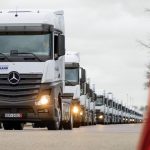Australasia transport in perspective

New Zealand puts out a safety alert for almost 3 000 truck trailers, builds new roads and edges towards an electric future, while Australia lags behind its peers. FOCUS reports on the transport industry in Australasia.
The New Zealand Transport Agency (NZTA) put out a safety warning for about 3 000 truck trailers in February, following multiple incidents of trailers dislocating from the truck body. Radio New Zealand (RNZ) reported on its website that the warning included refrigerated semi-trailers, of which 1 800 were urgently recalled to be recertified.
Truck drivers were warned to pay special attention when checking the vehicle, especially when the trailer has travelled 300 000 km, which RNZ estimates can be reached in 18 months. During testing, cracks were found in the skid plates and trailers certified by Peter Wastney of Peter Wastney Engineering were recalled for recertification.
According to RNZ, Wastney was suspended as a certifier in August, 2017, and as a chartered professional engineer earlier this year.
For truck drivers travelling on the Manawatū Gorge route, there is some good news as the NZTA has picked a new route to avoid erosion and mudslides caused by earthquakes, like the Woodville slip, which leads to frequent road closures on the current route. The Woodville slip led to the closure of the State Highway 3 since April, 2017.
According to the NZTA, the cost for the new route will be between NZ$ 390 million (R3,38 billion) and NZ$ 560 million (R4,85 billion). The expected drive time on the new 12,4 km route will be 13 minutes, almost four minutes shorter than the old route
“Everybody understands just how important it is to replace the Gorge route. It will re-establish a key strategic transport and freight link that supports the needs of the people and economies of central New Zealand,” says Emma Spegiht, NZTA regional relationships director, as quoted by RNZ.
Design of the road will take two years and construction will take four years. While the new route will avoid fault lines, about six farmers will have to give up land to allow for the construction of the road. The farming community in the area seems to accept the situation.
RNZ quotes Richard Morrison, president of the Federated Farmers: “The whole regional economy needs an efficient way through the gorge. We’ve seen the disruptions through that road in the last few years. To keep the country moving and to keep produce going back and forth, we need the good options and there’ll be probably winners and losers, depending on what course of action is chosen.”
The push for electric vehicles in Australasia is also growing. According to the New Zealand Herald, the New Zealand government invested NZ$ 8 million (R69 million) across 20 projects to get 64 000 electric vehicles on the New Zealand roads by 2021.
One of the projects includes designing and manufacturing electric trucks to shuttle dairy products. The project will be run by freight logistics companies Coda Group, Zero Emission Vehicles and Bay Dairy.
While New Zealand seems to be fast tracking electric vehicles, Australia seems to be lagging behind its global peers. In an opinion piece for the Australian website Newsport, columnist Crispin Hull noted that Paul Retter, chief executive and commissioner of the National Transport Commission, admitted that there are still major tax questions around electric vehicles.
He writes: “The position of Australia is made worse because it is a federation. The states jealously guard several key things: revenue from car registration; power over traffic enforcement; power to set the traffic rules; and power over compensation for personal injury on the road.”
Fuel-tax revenues will take the biggest plummet with the introduction of electric vehicles. Hull suggests: “The best and fairest way to get rid of the fuel-tax rebate is to abolish fuel tax and replace it with road-user taxes, which technology can do.”
Personal-injury insurance would also have to be reviewed. With self-driving vehicles, the compulsory third-party insurance, which traditionally covers driver negligence, is redundant as there is no driver. A revised law would have to hold liable either the owner of the vehicle or the manufacturer.
Australia is facing a catch-22 situation. Hull explains: “Insurance companies and governments will not be able to work out compensation schemes in the absence of data, and you cannot get data without the driverless cars being on the road.”
Part of why Australia lags behind might be the result of a lack of official commitment to renewable energy and electric vehicles. Australia has fewer electric vehicles compared to its peers with only 0,1 percent of new cars sold in Australia being electric.
The Australian Green Party is proposing a ban on internal combustion powered cars by 2030. This would include a 17-percent surcharge on the sales price of vehicles costing more than AU$ 65 000 (R602 045).
These vehicles currently have an additional 33-percent tax levy. Part of the additional 17-percent surcharge will go towards building infrastructure for charging of electric vehicles. Gail Broadbent, a researcher at New South Wales University, claims the lack of vehicle charging stations is one of the major factors preventing Australians from buying electric vehicles.
In his article for Clean Technica, Steven Hanley notes: “As Australia has no emissions standards for cars and light trucks at the moment, manufacturers are free to keep cranking out obsolete models and dumping them on Australian customers.”
The Green Party is also reportedly proposing a limit of 105 g/km for carbon emissions by 2022. Australia will have to drastically address and review its legal and tax frameworks if it aims to keep up with its peers and meet the requirements of Conference of the Parties (COP) Paris Agreement signed by the country.
Published by
Focus on Transport
focusmagsa




